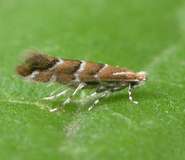Conker trees facing peril from alien invaders

(PhysOrg.com) -- Conkers, a favourite playground game in British schools, could soon be just a fond memory if a serious threat to horse chestnut trees continues to spread. Now academics from the Universities of Hull and Bristol are asking for the public's help in keeping an eye on the country's beloved conker trees, whose beauty is gradually being destroyed by an alien moth.
The horse chestnut leaf miner is an ‘alien’ (non-native) moth which arrived in the UK in 2002. Since then it has spread at a rate of 40 to 60 km per year and now covers half of the country, including much of south-central England, East Anglia, the Midlands and most recently East Yorkshire and Cornwall. This is the largest project of its kind in the UK and is funded by the Natural Environment Research Council (NERC).
This alien moth has caterpillars that live inside the leaves, forming distinctive patches of damage called ‘leaf mines’. Up to 700 leaf mines have been recorded on a single leaf and the damage caused by large numbers of larvae can be striking. Severely damaged leaves shrivel and turn brown by mid summer and fall early, well before the autumn, giving the impression that the tree is dead.
The spread and establishment of the horse chestnut leaf miner is of particular concern because, once established, the moth maintains exceptionally high rates of infestation without any evidence of decline. Although the moths do not kill the trees directly it appears that they weaken the trees, which then produce smaller conkers and may become more susceptible to lethal diseases.
No one knows exactly how far the miner infestation has spread so Dr Darren Evans and Dr Michael Pocock are inviting schools and members of the public to take part in an exciting national web-based experiment to monitor the rate of spread of this ‘alien’ insect and discover the natural pest-controlling insects that might control its spread.
Dr Michael Pocock from the University of Bristol explains: 'We are inviting people from all parts of the country to see if horse chestnut trees in their area have been infested. The whitish blotches on horse chestnut leaves that appear during the early summer are an indication that the ‘alien’ moths have arrived in their area. People can then log the location of the tree, either with or without the indication of alien moths, into our website.
‘The moth is spreading year-by-year and so this will give us the most up-to-date picture of the spread of this moth. Verified records will then be passed to Forest Research to add to its national database, which has been recording the spread of the moth since its arrival in 2002.’
The second part of the experiment will start in July, when members of the public can help to record the next stage of the invasion and the appearance of Nature’s pest controller.
Dr Darren Evans from the University of Hull explains: 'Nature’s form of defence against this alien invader is a tiny parasitic wasp which eats the moth caterpillars from the inside out - the wasps are the natural pest controllers. We think there is a time lag between the moth infesting a tree and the wasps attacking the caterpillars. We need the public’s help to test whether this is the case, especially in areas that have recently been invaded.'
Dr Pocock added: 'We are asking people at the beginning of July to take part in a simple, but important, study, using just a plastic bag, to see if their alien moths have been 'zapped’ by the natural pest controllers. We want them to collect a single infected horse chestnut leaf and put it into the bag. Within 2 weeks either moths or tiny parasitic wasps or possibly both should emerge. People can then record on our website what, if anything, comes out of their leaf, and so give us vital data to help us understand why this moth has spread so rapidly. We could even predict how well our conker trees will fare in the future.'
Dr Evans and Dr Pocock recently ran a pilot study in Bristol’s city centre to raise awareness about the effect of alien species on biodiversity; they used a large Jenga game to demonstrate that we rely on nature and the fact that once enough animals and plants are taken away, there can be a catastrophic effect on people.
Dr Evans explained: 'Any alien species is a major threat to biodiversity because all organisms live in relation to each other and once an imbalance occurs, the whole system could begin to unravel. The horse chestnut leaf miner is just one example of how destructive an alien species can be.'
More information: To find out more and to take part in this important experiment visit the project's website.
Provided by University of Bristol
















